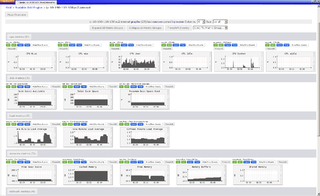
In computer networking, multicast is a type of group communication where data transmission is addressed to a group of destination computers simultaneously. Multicast can be one-to-many or many-to-many distribution. Multicast differs from physical layer point-to-multipoint communication.
In computer networking, the User Datagram Protocol (UDP) is one of the core communication protocols of the Internet protocol suite used to send messages to other hosts on an Internet Protocol (IP) network. Within an IP network, UDP does not require prior communication to set up communication channels or data paths.
Berkeley sockets is an application programming interface (API) for Internet sockets and Unix domain sockets, used for inter-process communication (IPC). It is commonly implemented as a library of linkable modules. It originated with the 4.2BSD Unix operating system, which was released in 1983.

In computer networking, the transport layer is a conceptual division of methods in the layered architecture of protocols in the network stack in the Internet protocol suite and the OSI model. The protocols of this layer provide end-to-end communication services for applications. It provides services such as connection-oriented communication, reliability, flow control, and multiplexing.

Extensible Messaging and Presence Protocol is an open communication protocol designed for instant messaging (IM), presence information, and contact list maintenance. Based on XML, it enables the near-real-time exchange of structured data between two or more network entities. Designed to be extensible, the protocol offers a multitude of applications beyond traditional IM in the broader realm of message-oriented middleware, including signalling for VoIP, video, file transfer, gaming and other uses.
The Financial Information eXchange (FIX) protocol is an electronic communications protocol initiated in 1992 for international real-time exchange of information related to securities transactions and markets. With trillions of dollars traded annually on the NASDAQ alone, financial service entities are employing direct market access (DMA) to increase their speed to financial markets. Managing the delivery of trading applications and keeping latency low increasingly requires an understanding of the FIX protocol.
In computer science and networking in particular, a session is a time-delimited two-way link, a practical layer in the TCP/IP protocol enabling interactive expression and information exchange between two or more communication devices or ends – be they computers, automated systems, or live active users. A session is established at a certain point in time, and then ‘torn down’ - brought to an end - at some later point. An established communication session may involve more than one message in each direction. A session is typically stateful, meaning that at least one of the communicating parties needs to hold current state information and save information about the session history to be able to communicate, as opposed to stateless communication, where the communication consists of independent requests with responses.

The Blocks Extensible Exchange Protocol (BEEP) is a framework for creating network application protocols. BEEP includes building blocks like framing, pipelining, multiplexing, reporting and authentication for connection and message-oriented peer-to-peer (P2P) protocols with support of asynchronous full-duplex communication.

In software engineering, dependency injection is a programming technique in which an object or function receives other objects or functions that it requires, as opposed to creating them internally. Dependency injection aims to separate the concerns of constructing objects and using them, leading to loosely coupled programs. The pattern ensures that an object or function that wants to use a given service should not have to know how to construct those services. Instead, the receiving 'client' is provided with its dependencies by external code, which it is not aware of. Dependency injection makes implicit dependencies explicit and helps solve the following problems:

Ganglia is a scalable, distributed monitoring tool for high-performance computing systems, clusters and networks. The software is used to view either live or recorded statistics covering metrics such as CPU load averages or network utilization for many nodes.
In computer networking, a reliable protocol is a communication protocol that notifies the sender whether or not the delivery of data to intended recipients was successful. Reliability is a synonym for assurance, which is the term used by the ITU and ATM Forum.
A network socket is a software structure within a network node of a computer network that serves as an endpoint for sending and receiving data across the network. The structure and properties of a socket are defined by an application programming interface (API) for the networking architecture. Sockets are created only during the lifetime of a process of an application running in the node.
Transparent Inter Process Communication (TIPC) is an inter-process communication (IPC) service in Linux designed for cluster-wide operation. It is sometimes presented as Cluster Domain Sockets, in contrast to the well-known Unix Domain Socket service; the latter working only on a single kernel.
Jakarta Mail is a Jakarta EE API used to send and receive email via SMTP, POP3 and IMAP. Jakarta Mail is built into the Jakarta EE platform, but also provides an optional package for use in Java SE.
The Secure Real-Time Media Flow Protocol (RTMFP) is a protocol suite developed by Adobe Systems for encrypted, efficient multimedia delivery through both client-server and peer-to-peer models over the Internet. The protocol was originally proprietary, but was later opened up and is now published as RFC 7016.
In data networking, telecommunications, and computer buses, an acknowledgement (ACK) is a signal that is passed between communicating processes, computers, or devices to signify acknowledgment, or receipt of message, as part of a communications protocol. Correspondingly an negative-acknowledgement is a signal that is sent to reject a previously received message or to indicate some kind of error. Acknowledgments and negative acknowledgments inform a sender of the receiver's state so that it can adjust its own state accordingly.
Constrained Application Protocol (CoAP) is a specialized UDP-based Internet application protocol for constrained devices, as defined in RFC 7252. It enables those constrained devices called "nodes" to communicate with the wider Internet using similar protocols. CoAP is designed for use between devices on the same constrained network, between devices and general nodes on the Internet, and between devices on different constrained networks both joined by an internet. CoAP is also being used via other mechanisms, such as SMS on mobile communication networks.
NACK-Oriented Reliable Multicast (NORM) is a transport layer Internet protocol designed to provide reliable transport in multicast groups in data networks. It is formally defined by the Internet Engineering Task Force (IETF) in Request for Comments (RFC) 5740, which was published in November 2009.
IDTP is a communication protocol to tracing messages of things identified by UTDIs (Utid), which adapt request/response model and like a hybrid of HTTP and Web Service but using JSON data format rather than XML format.
Network Device Interface (NDI) is a software specification developed by the technology company NewTek. It enables high-definition video to be transmitted, received, and communicated over a computer network with low latency and high quality. This royalty-free specification supports frame-accurate switching, making it suitable for live production environments.





